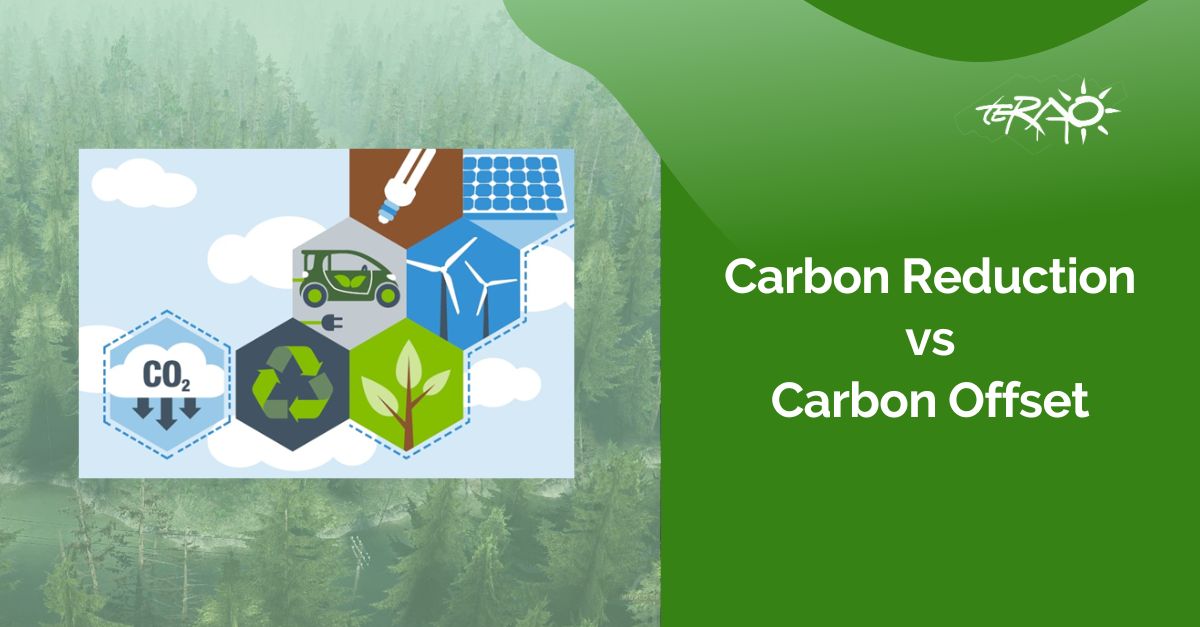Carbon reduction and carbon offset are two terms that are often used interchangeably, but they have different meanings and implications. In this article, we will explain what they are, why they matter, and how they can help you reduce your environmental impact.
Carbon reduction is the process of decreasing the amount of greenhouse gas emissions that you produce, either directly or indirectly. For example, you can reduce your carbon footprint by optimizing your energy use, reducing your consumption, eating less meat, using renewable energy sources instead of fossil fuels, taking more public transport, etc. Carbon reduction is the most effective way to combat climate change, as it prevents more emissions from entering the atmosphere.

Carbon offset is the process of compensating for the emissions that you cannot avoid by supporting projects that reduce or remove emissions elsewhere. For example, you can offset your carbon footprint by investing in clean energy projects, supporting community development initiatives, or planting trees. Carbon offset can be done voluntarily or as part of a compliance scheme. Voluntary offsetting means that you choose to buy carbon credits from a certified provider that verifies the emission reductions of the projects you support.

Carbon offset is a complementary and supplementary strategy to carbon reduction, as it allows us to balance out our residual emissions and achieve net zero carbon. However, carbon offset is NOT a substitute for carbon reduction, as it does not address the root causes of climate change and may have limitations and uncertainties in terms of quality, permanence, additionality, and leakage.
Why are carbon reduction and carbon offset important?
Carbon reduction and carbon offset are important for several reasons. First, they can help you comply with environmental regulations and standards that may apply to your industry or location. For example, some countries have implemented carbon taxes or cap-and-trade systems that require businesses to pay for their emissions or limit them to a certain level. By reducing and offsetting your emissions, you can avoid fines or penalties and gain a competitive edge.
Second, they can help you enhance your reputation and brand image among your customers, investors, employees, and partners. Consumers are becoming more aware and concerned about the environmental impact of their purchases and preferences. By showing that you are committed to sustainability and social responsibility, you can attract and retain loyal customers who share your values. Investors are also looking for businesses that have a positive environmental, social, and governance (ESG) performance, as they tend to have lower risks and higher returns. Employees and partners are also more likely to work with or for businesses that align with their personal beliefs and goals.
Third, they can help you improve your efficiency and innovation. By reducing your energy consumption and waste generation, you can lower your operational costs and increase your profitability. By investing in renewable energy sources and low-carbon technologies, you can diversify your energy portfolio and reduce your dependence on fossil fuels. By adopting green practices and products, you can create new market opportunities and differentiate yourself from your competitors.
The differences between carbon reduction and carbon offset
Carbon reduction and carbon offset are both important tools in the fight against climate change, but they have different roles and impacts. Here are some of the main differences:
Carbon reduction involves reducing the amount of emissions that we produce, while carbon offset involves compensating for the emissions that we cannot avoid or reduce. Carbon reduction reduces the source of the problem, while carbon offsetting mitigates the impact of the problem.
In terms of immediacy and efficacy, carbon reduction delivers a direct and immediate effect on our emissions, while carbon offset has an indirect and delayed effect on someone else’s emissions. Carbon reduction reduces our contribution to climate change, while carbon offset relies on the actions of others to balance out our contribution.
Carbon reduction is proactive, while carbon offset is reactive. Carbon reduction prevents emissions from happening in the first place, while carbon offset compensates for emissions that have already occurred or are unavoidable.
Moreover, carbon reduction is more reliable, while carbon offset is more variable. Carbon reduction can be measured and verified more easily, while carbon offset depends on the quality and credibility of the projects that generate the offsets. Some projects may not deliver the expected emission reductions or may have negative side effects on the environment or local communities.
Carbon reduction is more cost-effective, while carbon offset is more flexible. Carbon reduction can save money in the long run by reducing energy bills, improving productivity, or creating new markets. Carbon offset can provide a cheaper and faster way to meet emission targets or commitments without changing business practices or behaviors.
Both carbon reduction and carbon offset are important for achieving a net-zero carbon economy, which means that the amount of emissions we produce is equal to or less than the amount of emissions we remove. This is the goal of the Paris Agreement, which aims to limit global warming to well below 2°C above pre-industrial levels.
However, not all carbon reduction and carbon offset projects are created equal. Some may have unintended consequences, such as displacing local communities, harming biodiversity, or creating perverse incentives. Therefore, it is essential to choose credible and verified projects that adhere to high standards of quality, transparency, and accountability.
How can you implement Carbon Reduction and Carbon Offset in your business?
To implement carbon reduction and carbon offset in your business, you need to follow these steps:
- Measure your carbon footprint: This is the amount of greenhouse gas emissions that your business generates from its activities. You can use online tools or consult experts such as TERAO to calculate your footprint based on various factors, such as energy use, transportation, waste generation, etc.

2. Set your reduction target: This is the amount of emissions that you aim to reduce over a certain period. You can base your target on industry standards or best practices or align it with international commitments or regulations.
3. Implement your reduction plan: This is the set of actions that you will take to achieve your reduction target. You can use various methods to reduce your emissions, such as switching to renewable energy sources (e.g., solar panels), improving your energy efficiency (e.g., LED lighting), reducing waste (e.g., recycling), or adopting low-carbon practices (e.g., telecommuting).

4. Monitor and report your progress: This is the process of tracking and communicating your results and achievements. You can use indicators or metrics to measure your performance and compare it with your baseline and target. You can also use reporting frameworks or standards to disclose your information to stakeholders or authorities.
5. Follow-up the carbon reductions month by month, year by year: big companies have already reported their targets through the SBTI website and made public claims about their Carbon reduction goals. They are asked to report their carbon footprint year by year, to follow up if the goals of reduction have been met or not.
6. Purchase offsets for remaining emissions: This is the final step after you have reduced your emissions as much as possible. You can buy offsets from reputable providers or platforms that offer a range of projects that suit your preferences and budget. You can also choose projects that align with your values or goals, such as supporting local communities or protecting biodiversity.

TERAO as a Building Sustainability Engineering Consultancy can provide you with support in calculating your carbon footprint. TERAO has been a pioneer of the Bioclimatic design approach in tropical and sub-tropical climates; and an expert in passive design strategies, focusing on maximizing the building envelope performance. If you have any questions or would like to learn more, please don’t hesitate to contact our Business Development Director Gaspard at glemoinescelles@teraoasia.com




Leave A Comment